 |
| GREEN |
|
Color
mixing takes place when two or more colors come together
to form a different color. There are two basic systems
of mixing colors. One system of color mixing takes place
when mixing colorants such as paint, ink and dyes.
|
| The
other method of color mixing takes place when two or more
colored light sources are combined. An example of this type of mixing
takes place when our eyes blend together the tiny dots or
stripes that make up the color images on
televisions, monitors and tablet screens. |
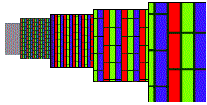 |
|
The tiny lines or stripes on a video screen may be
seen with a magnifying lens. |
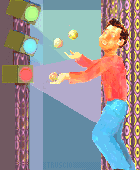 |
Another example of mixing color is when various colored stage lights
overlap over the same area. |
| Any two or more colors can be mixed to form
different colors. However, only three basic colors are needed to
create just about all other colors. For this reason, these are
referred to as "primary" colors. |
|
It is important to
note that the three primary colors for mixing paint, ink
and dyes are not the same three primary colors that are used
when mixing light. So there are two groups or sets of primary colors. |
 |
The three
basic colors used for mixing paint, dyes and inks are
cyan, yellow and magenta. They are called the
"subtractive" primary colors. |
 |
The three basic colors used for
mixing light or illumination are red, green and blue.
They are called the "additive" primary colors.
|
|
|
|
|
|
These two sets of primary colors
are connected in an important way.
The diagram below shows that where any
two subtractive primary colors (cyan, magenta or yellow) are mixed together using
paint, inks or dyes, the two colors mix to make
one of the additive
primary colors of light (red, green or blue). The
curved color arrows show which two subtractive colors
are mixed to form the additive colors.
|
MIXING PAINTS, INKS AND DYES USING CYAN,
MAGENTA AND YELLOW
| |
MAGENTA |
ADDITIVE |
|
|
SUBTRACTIVE |
(RED) |
|
ADDITIVE
(BLUE) |
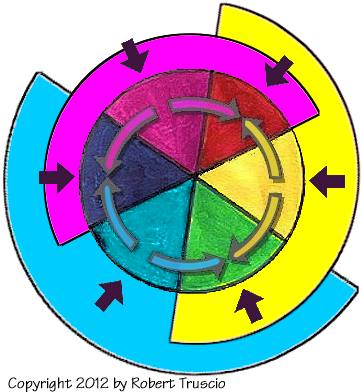 |
YELLOW
SUBTRACTIVE |
| |
CYAN |
ADDITIVE |
|
|
SUBTRACTIVE |
(GREEN) |
|
|
|
|
The fact that any two of
the cyan, yellow and magenta primary colors mix to form
either the red,
green or blue primary colors of light underscores the
link between these two sets of colors. |
|
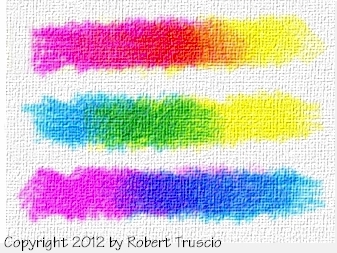 |
Magenta and yellow mix to make
red. |
|
Cyan and yellow mix to make
green. |
|
Magenta and cyan mix to make
blue. |
|
 |
The primary color cyan is a bright blue hue.
The primary color magenta
is a bright deep pink. The primary color yellow is a bright yellow.
|
|
Cyan, yellow and magenta are the three
basic colors used for the inks used in most
computer printers and for the commercial printing of books and
magazines. They are the three colors that are used for the dyes
in color photo and movie film. When colors are mixed in this
way, they are relying on the "subtractive" color mixing process.
MIXING ILLUMINATION
 |
The three basic colors for mixing illumination
are not the same as for mixing dyes, paints
or inks. The three basic colors of illumination
are red, green and blue. The way color
illumination mixes to make other colors is
different from what happens when paint or inks
are mixed. |
|
|
Where any two colors of red,
blue or green illumination overlap, they form one of the
cyan, yellow or magenta colors used for mixing paint,
dyes, filters or inks. Once again, we see a connection
between the two sets of primary colors. |
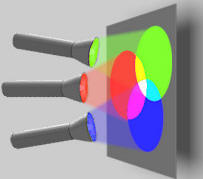 |
| There
is another interesting difference between the mixing of
paint and the mixing of illumination. The
final colors that we see as a
result of mixing colored illumination as compared to
mixing paint or dyes are not the same. For example, when
mixing paint, red and green paint mix to form a darker color
(brown). However, when mixing the same colors using
illumination, red and green mix to form a lighter color
(yellow). |
| |
| SAME COLORS - DIFFERENT
RESULTS |
| |
| SUBTRACTIVE
MIXING |
|
ADDITIVE MIXING |
| PAINTS - INKS -
DYES |
|
ILLUMINATION |
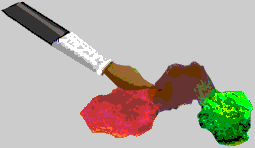 |
|
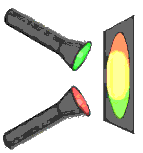 |
| Red and green paint mix to make brown, a darker
color. |
|
Red light added to green light
mix to produce yellow, a lighter
color. |
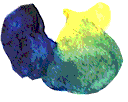 |
|
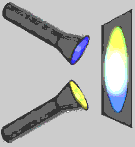 |
| A mixture of blue and yellow paint produces a
greenish color. |
|
A mixture of blue and yellow
illumination appears white. |
| PAINT - INKS - DYES |
|
ILLUMINATION |
 |
|
 |
|
|
|
|
|
| |
|
|
All three subtractive colors mix to form
black. All three additive colors combine to form white.
| Subtractive |
Additive |
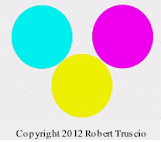 |
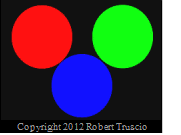 |
| Paint, Ink, Dye |
Light |
For more about how these six colors are
related to each other, select
"Subtractive Color" and "Photos" on the tabs
at the top of this page
WHICH KIND OF COLOR MIXING IS USED WHEN?
Note: Even
though there are two ways to mix color, all color
mixing depends on light. Without light, we would see
nothing at all. When we are dealing with paint
colors, we are seeing these colors as a result of
mixtures of reflected light. For more about this, click on,
"Subtractive Color" on the tabs at the top
this page.
|